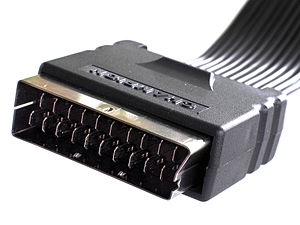
Back سكارت Arabic Euroconector AST SCART Byelorussian Euroconnector Catalan SCART Czech SCART German SCART Greek Euroconector Spanish SCART Estonian Eurokonektore Basque
This article has multiple issues. Please help improve it or discuss these issues on the talk page. (Learn how and when to remove these messages)
|
 A male SCART connector (21-pin) | |||
| Type | Analogue audio and video connector | ||
|---|---|---|---|
| Production history | |||
| Designer | CENELEC | ||
| Designed | 1976 | ||
| Superseded | RCA, DIN (in Europe) | ||
| Superseded by | HDMI, DisplayPort | ||
| General specifications | |||
| Audio signal | Bi-directional Stereo | ||
| Video signal |
Composite (bi-directional), RGB (uni-directional), S-Video (sometimes bi-directional), or YPbPr (Component) | ||
| Pins |
21 (21 wires:RGB/10 wires:CVBS) 10 (10 wires:CVBS) | ||
| Data | |||
| Data signal | D²B and widescreen switching | ||
| Pinout | |||
 | |||
| Female connector seen from the front | |||
| Pin 1 | Audio output (right) | ||
| Pin 2 | Audio input (right) | ||
| Pin 3 | Audio output (left/mono) | ||
| Pin 4 | Audio ground (pins 1, 2, 3 & 6 ground) | ||
| Pin 5 | RGB Blue ground (pin 7 ground) | ||
| Pin 6 | Audio input (left/mono) | ||
| Pin 7 |
RGB Blue up S-Video C down[a] Component PB up[b] | ||
| Pin 8 |
Status & Aspect Ratio up[c]
| ||
| Pin 9 | RGB Green ground (pin 11 ground) | ||
| Pin 10 |
Clock / Data 2[d] Control bus (AV.link) | ||
| Pin 11 |
RGB Green up Component Y up[b] | ||
| Pin 12 | Reserved / Data 1[d] | ||
| Pin 13 | RGB Red ground (pin 15 ground) | ||
| Pin 14 | Usually Data signal ground (pins 8, 10 & 12 ground) | ||
| Pin 15 |
RGB Red up S-Video C up Component PR up[b] | ||
| Pin 16 |
Blanking signal up
| ||
| Pin 17 | Composite video ground (pin 19 & 20 ground) | ||
| Pin 18 | Blanking signal ground (pin 16 ground) | ||
| Pin 19 |
Composite video output S-Video Y output | ||
| Pin 20 |
Composite video input S-Video Y input | ||
| Pin 21 | Shell/Chassis[e] | ||
|
output/input denotes symmetrical links | |||
SCART (also known as Péritel or Péritélévision, especially in France, 21-pin EuroSCART in marketing by Sharp in Asia, Euroconector in Spain,[1] EuroAV or EXT, or EIA Multiport in the United States, as an EIA interface) is a French-originated standard and associated 21-pin connector for connecting audio-visual (AV) equipment. The name SCART comes from Syndicat des Constructeurs d'Appareils Radiorécepteurs et Téléviseurs, "Radio and Television Receiver Manufacturers' Association", the French organisation that created the connector in the mid-1970s. The related European standard EN 50049 was refined and published in 1978 by CENELEC, calling it péritelevision, but it is commonly called by the abbreviation péritel in French.
The signals carried by SCART include both composite and RGB (with composite synchronisation) video, stereo audio input/output and digital signalling. SCART is also capable of carrying S-Video signals, using the red pins for chroma.[2] A TV can be woken from standby mode and automatically switch to the appropriate AV channel when the SCART attached device is switched on. SCART was also used for high definition signals such as 720p, 1080i, 1080p with YPbPr connection by some manufacturers, but this usage is scarce due to the advent of HDMI.[citation needed]
In Europe, SCART was the most common method of connecting AV equipment and was a standard connector for such devices; it was far less common elsewhere.
The official standard for SCART is CENELEC document number EN 50049–1. SCART is sometimes referred to as the IEC 933-1 standard.
- ^ "Conector SCART (Euroconector)". uvigo.es. Retrieved 17 November 2016.
- ^ "S-Video and SCART interconnection cable pinout". Pinout Guide. Retrieved 19 April 2023.